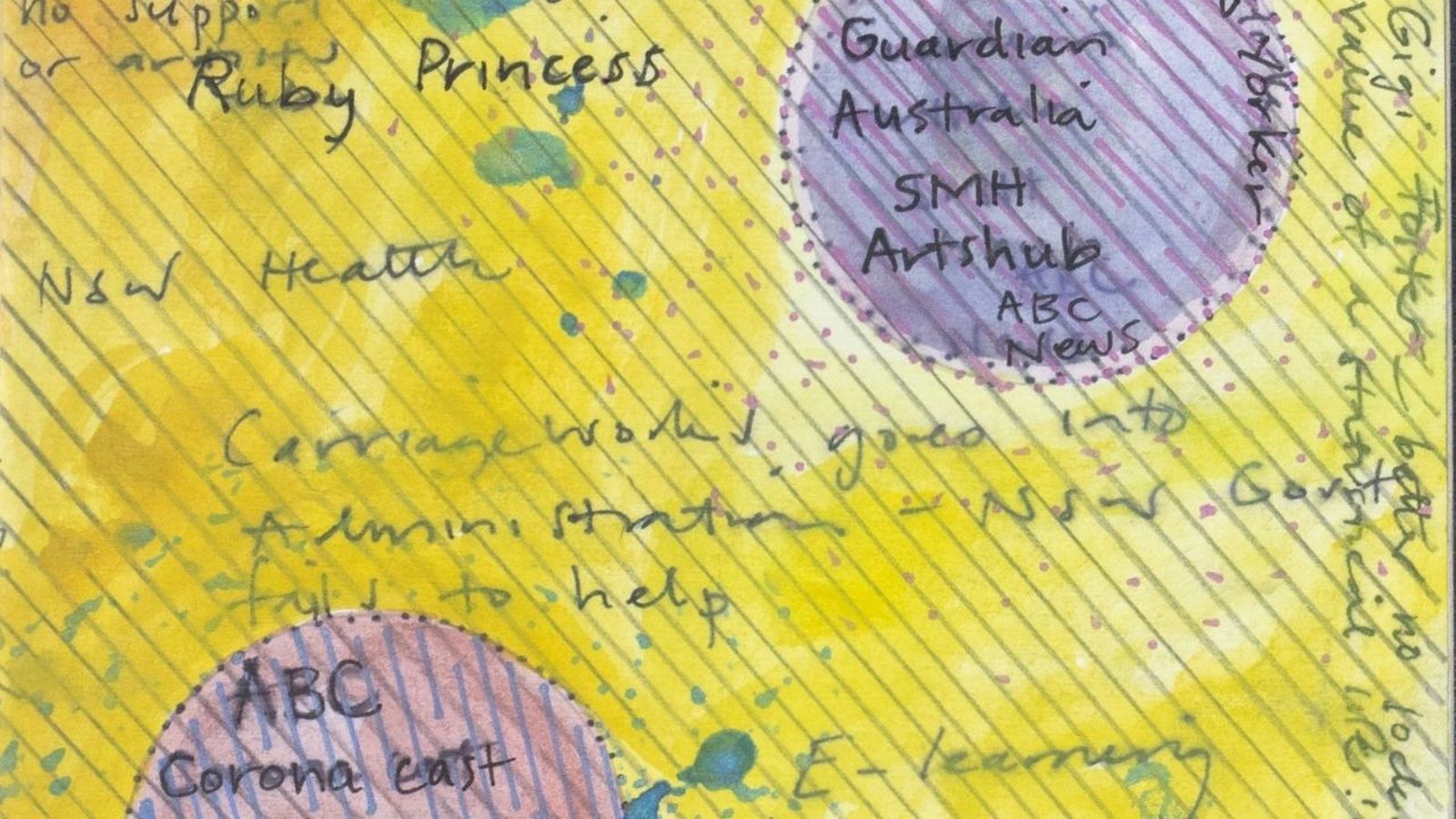Pia Larsen

Pia Larsen
Artist and educator Pia Larsen lives in Sydney. Pia’s journal represents a record of observations and responses to the global situation and political philosophy. Combining paper collages and “swirling ink”, Pia documented her resistance to the overwhelming pandemic.
We asked Pia three questions about her experience of isolation, completing this journal and her hope for the future. These are her responses:
Describe the experience of the period of isolation for you.
The experience of isolation has been a mix of intense anxiety in the early weeks, (second half of March), involving too much reading of the Covid-19 horrors unfolding around the world, in Wuhan, Italy, New York soon followed by Britain, France, Brazil…… Along with making the necessary changes at home with family; to shop as little as possible to minimize exposure, adhere to more handwashing and to limit touching surfaces in the public space, particularly, and social distance from everyone except immediate family, and stay at home. There came a point where I felt I needed to better manage my anxiety by focussing less on the perpetual news cycle and more on my art projects and upcoming solo exhibition at the Mildura Art Centre scheduled for July and work for a show in Canberra, also in July. Everything required readjustment and it took time to develop the skills to better manage the flux going on around me.
What does your book represent and how did you approach the challenge?
My journal represents a record of observations and responses to the world grappling with the pandemic and fallout from its effects on people, communities, businesses, public and private confidence and economies. Leadership, public infrastructure, health systems, political philosophy were all under pressure to respond to a highly contagious virus no-one can control. Each Nations degree of socio-economic inequality revealed as leaders responded according to long-held beliefs with a willingness to adapt and accept what was necessary to save lives, or incompetence, cruelty, (Sweden/US/Brazil!) and partisan politics that has killed and will continue to kill millions of people around the world. The journal narrative unfolds from the beginning of the lockdown, mid-March, until every page had been filled by the 26.6.20. Sometimes I responded intuitively capturing and giving form to mood and thoughts with colour, pattern, shapes and layering. At other times I re-presented work undertaken at a larger scale in fragments or folded in on itself to fit the journal page. ‘Isolation’ presents a pontoon in an empty harbour pool as a symbol of our isolation and separation from others under Covid-19. The concept augmented by tearing the image into pieces and filling the spaces between with swirling ink.
What do you hope will change in Australia as a result of the pandemic?
The things I hope will change in Australia include: an acceptance and acknowledgement by the federal government that climate change must be responded to immediately, particularly in ending support for high emitting industry and moving to sustainable low-emitting industries. Given how well they have responded to the threat of Covid-19 it should also follow that they make the connection between what humans are doing to the planet and the emergence of viruses, other diseases and the rapidly increasing animal/human/environmental collapse. That more Australians stop kidding themselves that this is a great country for all, stop regarding the poor and homeless as victims of their own misfortune and accept that public provision of aged care, housing, education, roads, Medicare, etc is the job of government requiring higher taxes and more equitable taxation particularly for the very wealthy who pay little or no tax at the present. That Australia brings in the Living Wage. That politicians and those with a public platform speak about the value of culture and the arts as essential for, living a meaningful and reflected-upon life, and for the well-being of individuals and the human collective. Celebrate, fund and promote Australian voices as expressions of who we are and how we see ourselves. Enable all Australians to understand the importance of reconciling our troubled past of colonial invasion and destruction of indigenous culture through for example, an indigenous voice to parliament and much greater presence of Indigenous voices in how Australia thinks of itself and presents to the world.
Pia Larsen is an artist, writer and teacher whose practice incorporates print, sculpture and text. She works with ideas that consider the connections and tensions between people and place, language and history. She will have a solo show, Dreams of Another Life, at the Mildura Art Centre, July-September 2020, as well as work in a group show, HHG/GOST online, Canberra. Curated shows include the Megalo Print Studio, Relief Online Exhibition, (International), 2020, Sydney Contemporary/ Future Contemporary with O House Studios, 2019 and IMPRINT: Survey of the PCA, Parliament House, ACT, 2019. She has an MVA from Sydney College of the Arts, University of Sydney and has exhibited widely in solo and group shows. She was represented by the Damien Minton Gallery from 2008-2012. Her work is held in collections that include, Sydney City Council, Art Bank, PCA, Canson Australia (Corporate Collection), UWS Macarthur and the Women’s Studio Workshop, New York.
View Pia Larsen's journal here:
Image: Pia Larsen, Design/Isolate Journal (detail), 2020.
